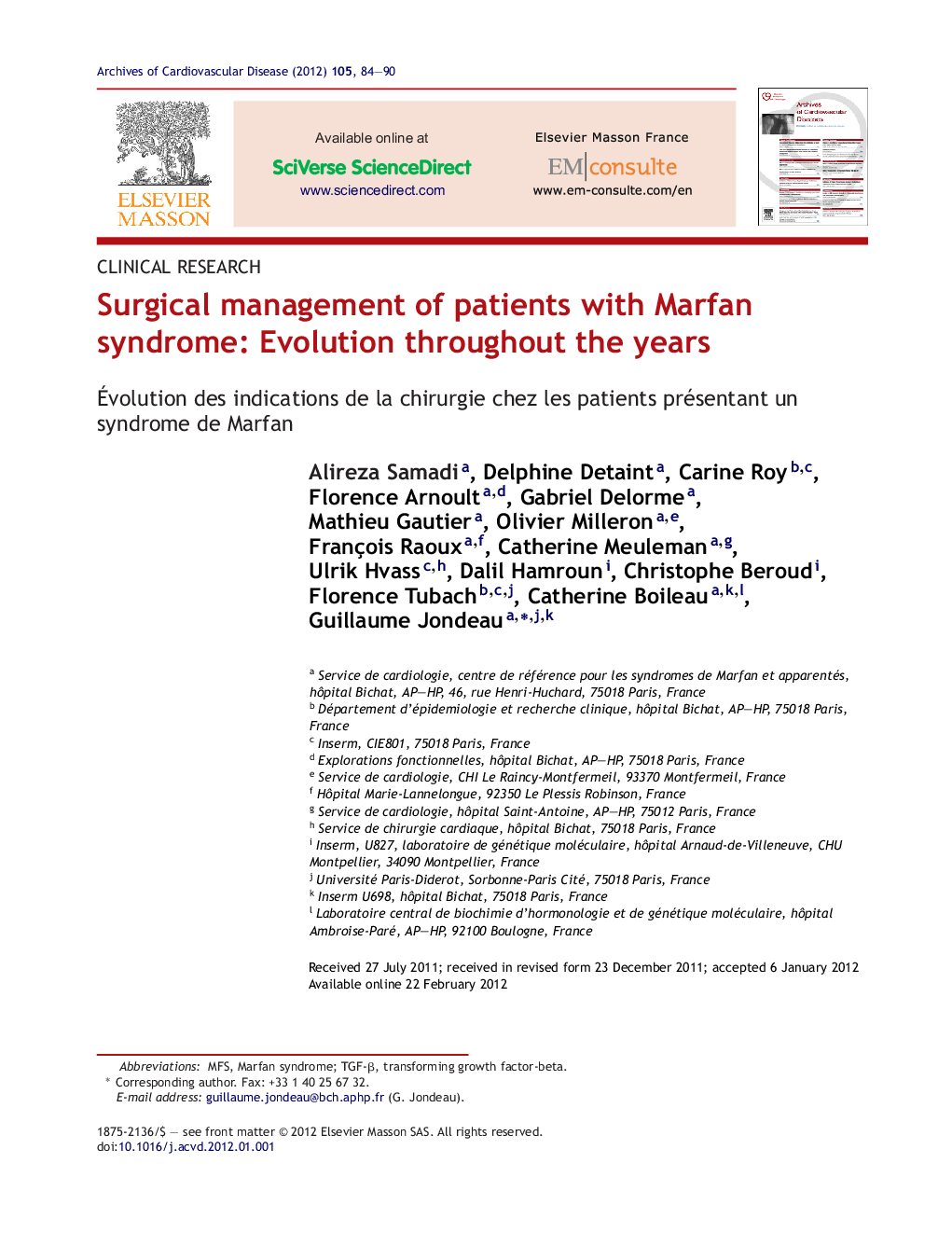| کد مقاله | کد نشریه | سال انتشار | مقاله انگلیسی | نسخه تمام متن |
|---|---|---|---|---|
| 2889513 | 1574377 | 2012 | 7 صفحه PDF | دانلود رایگان |

SummaryAimTo evaluate the evolution of surgical management in a large population of patients with Marfan syndrome.MethodsThis is a retrospective study of patients fulfilling the Ghent criteria for Marfan syndrome, who visited the Centre de référence national pour le syndrome de Marfan et apparentés and underwent a surgical event before or during follow-up in the centre.ResultsOne thousand and ninety-seven patients with Marfan syndrome, according to international criteria, came to the clinic between 1996 and 2010. Aortic surgery was performed in 249 patients (22.7%; 20 children and 229 adults), including the Bentall procedure in 140 patients (56%) and valve-sparing surgery in 88 patients (35%); a supracoronary graft was performed in 19 patients (7.6%), usually for aortic dissection. During the past 20 years, the predominant reason for aortic surgery has switched from aortic dissection to aortic dilatation, while age at surgery has tended to increase (from 32.4 ± 11.9 years to 35.2 ± 12.4 years; P = 0.075). Mitral valve surgery was performed in 61 patients (5.6%; six children and 55 adults), including 37 valvuloplasties (60.6%) and 18 mitral valve replacements (29.5%). No significant difference was observed when comparing mitral valve surgery before and after 2000.ConclusionSurgery performed in patients with Marfan syndrome has switched from emergency surgery for aortic dissection to elective surgery for aortic dilatation; this is associated with surgery performed at an older age despite the indication for surgery having decreased from 60 mm to 50 mm. No significant evolution was observed for mitral valve surgery.
RésuméButApprécier l’évolution de la prise en charge chirurgicale des patients présentant un syndrome de Marfan.MéthodesÉtude rétrospective portant sur les patients qui ont été vu au Centre national de référence pour le syndrome de Marfan et apparentés, remplissant les critères de Ghent et ayant subi une intervention chirurgicale avant ou pendant leur suivi dans le centre.RésultatsMille quatre-vingt dix-sept patients présentant un syndrome de Marfan selon les critères internationaux ont été vus entre 1996 et 2010. La chirurgie aortique a été pratiquée chez 249 (22,7 % ; 20 enfants et 229 adultes), soit une intervention de Bentall (n = 140, 56 %), soit une intervention préservant la valve aortique (n = 88, 35 %). Chez les 19 derniers patients (7,6 %), un tube sus-coronaire a été mis en place, en règle pour dissection aortique. Au cours des 20 dernières années, l’indication principale de la chirurgie a changé de dissection aortique à dilatation aortique, ce alors que l’âge de la chirurgie avait tendance à augmenter (32,4 ± 11,9 ans vs 35,2 ± 12,4 ans, avant et après 2000 ; p = 0,075). La chirurgie valvulaire mitrale a été pratiquée chez 61 patients (5,6 % ; six enfants et 55 adultes), à type de plastie chez 37 (60,6 %) et de remplacement valvulaire chez 18 (29,5 %). Les chiffres restent similaires avant et après l’année 2000.ConclusionLa chirurgie réalisée chez les patients présentant un syndrome de Marfan et autrefois principalement une chirurgie d’urgence pour dissection est maintenant surtout une chirurgie programmée pour dilatation aortique. Cela alors que les patients sont opérés plus tard alors que le seuil chirurgical a baissé de 60 à 50 mm. Les indications et le type de chirurgie mitrale n’ont pas évolué.
Journal: Archives of Cardiovascular Diseases - Volume 105, Issue 2, February 2012, Pages 84–90